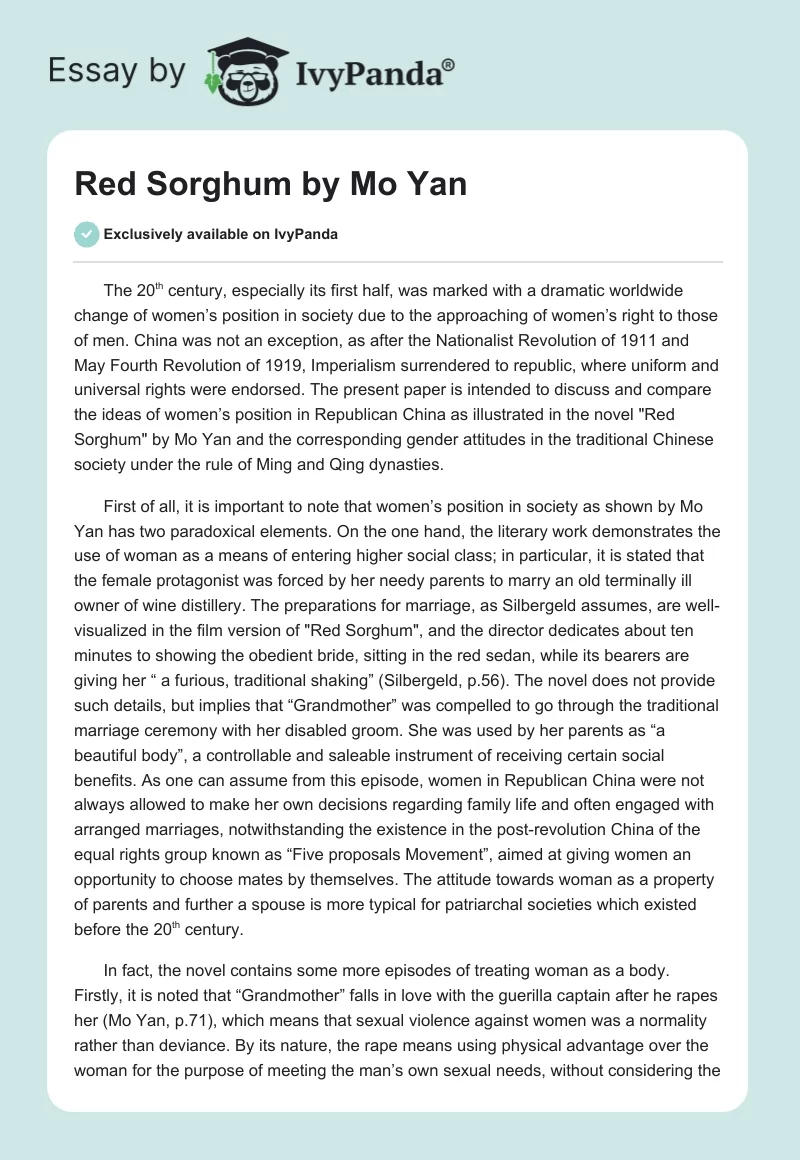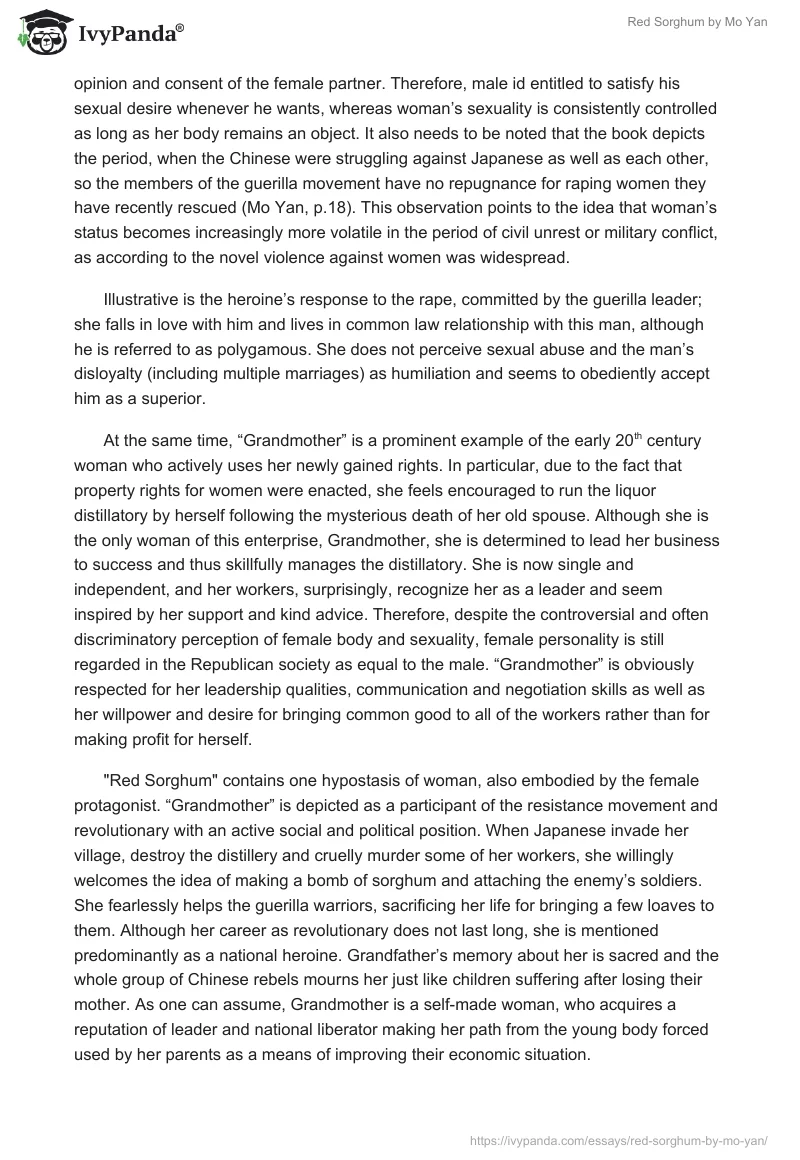The 20th century, especially its first half, was marked with a dramatic worldwide change of women’s position in society due to the approaching of women’s right to those of men. China was not an exception, as after the Nationalist Revolution of 1911 and May Fourth Revolution of 1919, Imperialism surrendered to republic, where uniform and universal rights were endorsed. The present paper is intended to discuss and compare the ideas of women’s position in Republican China as illustrated in the novel “Red Sorghum” by Mo Yan and the corresponding gender attitudes in the traditional Chinese society under the rule of Ming and Qing dynasties.
First of all, it is important to note that women’s position in society as shown by Mo Yan has two paradoxical elements. On the one hand, the literary work demonstrates the use of woman as a means of entering higher social class; in particular, it is stated that the female protagonist was forced by her needy parents to marry an old terminally ill owner of wine distillery. The preparations for marriage, as Silbergeld assumes, are well-visualized in the film version of “Red Sorghum”, and the director dedicates about ten minutes to showing the obedient bride, sitting in the red sedan, while its bearers are giving her “ a furious, traditional shaking” (Silbergeld, p.56). The novel does not provide such details, but implies that “Grandmother” was compelled to go through the traditional marriage ceremony with her disabled groom. She was used by her parents as “a beautiful body”, a controllable and saleable instrument of receiving certain social benefits. As one can assume from this episode, women in Republican China were not always allowed to make her own decisions regarding family life and often engaged with arranged marriages, notwithstanding the existence in the post-revolution China of the equal rights group known as “Five proposals Movement”, aimed at giving women an opportunity to choose mates by themselves. The attitude towards woman as a property of parents and further a spouse is more typical for patriarchal societies which existed before the 20th century.
In fact, the novel contains some more episodes of treating woman as a body. Firstly, it is noted that “Grandmother” falls in love with the guerilla captain after he rapes her (Mo Yan, p.71), which means that sexual violence against women was a normality rather than deviance. By its nature, the rape means using physical advantage over the woman for the purpose of meeting the man’s own sexual needs, without considering the opinion and consent of the female partner. Therefore, male id entitled to satisfy his sexual desire whenever he wants, whereas woman’s sexuality is consistently controlled as long as her body remains an object. It also needs to be noted that the book depicts the period, when the Chinese were struggling against Japanese as well as each other, so the members of the guerilla movement have no repugnance for raping women they have recently rescued (Mo Yan, p.18). This observation points to the idea that woman’s status becomes increasingly more volatile in the period of civil unrest or military conflict, as according to the novel violence against women was widespread.
Illustrative is the heroine’s response to the rape, committed by the guerilla leader; she falls in love with him and lives in common law relationship with this man, although he is referred to as polygamous. She does not perceive sexual abuse and the man’s disloyalty (including multiple marriages) as humiliation and seems to obediently accept him as a superior.
At the same time, “Grandmother” is a prominent example of the early 20th century woman who actively uses her newly gained rights. In particular, due to the fact that property rights for women were enacted, she feels encouraged to run the liquor distillatory by herself following the mysterious death of her old spouse. Although she is the only woman of this enterprise, Grandmother, she is determined to lead her business to success and thus skillfully manages the distillatory. She is now single and independent, and her workers, surprisingly, recognize her as a leader and seem inspired by her support and kind advice. Therefore, despite the controversial and often discriminatory perception of female body and sexuality, female personality is still regarded in the Republican society as equal to the male. “Grandmother” is obviously respected for her leadership qualities, communication and negotiation skills as well as her willpower and desire for bringing common good to all of the workers rather than for making profit for herself.
“Red Sorghum” contains one hypostasis of woman, also embodied by the female protagonist. “Grandmother” is depicted as a participant of the resistance movement and revolutionary with an active social and political position. When Japanese invade her village, destroy the distillery and cruelly murder some of her workers, she willingly welcomes the idea of making a bomb of sorghum and attaching the enemy’s soldiers. She fearlessly helps the guerilla warriors, sacrificing her life for bringing a few loaves to them. Although her career as revolutionary does not last long, she is mentioned predominantly as a national heroine. Grandfather’s memory about her is sacred and the whole group of Chinese rebels mourns her just like children suffering after losing their mother. As one can assume, Grandmother is a self-made woman, who acquires a reputation of leader and national liberator making her path from the young body forced used by her parents as a means of improving their economic situation.
During the Ming and Qing periods, the position of women in society was fully determined by their intrafamilial status. In particular, each household was traditionally represented by father or patriarch (grandfather) and in commercial operations the male leader was responsible for managing the family assets, registering and signing contacts and agreements. Even windowed women had no power to own property and manage land assets or business, whereas in “Red Sorghum”, Grandmother becomes an owner and director of the distillery. Furthermore, in the periods of the Ming and Qing rule, males were allowed to take half-wives (concubines) as well as the official spouse. At the same time, in the Ming period, inter-class marriages were endorsed, as family laws gave a commoner an opportunity to connect his life through official ceremony with a prostitute or a slave. Considering the book by Mo Yan, one can assume that polygamy survived until the days of Republican China, as
In the 13th-19th century China, widows were also encouraged to remain loyal to their deceased husbands so that they were prevented from remarrying, having children with the second husband and dividing the property of the deceased spouse among the children from the second marriage. At the same time, the female heroine of “Red Sorghum” actually engaged with a non-marital relationship after the death of her husband. Due to the fact that this action is not described with resentment or critical judgment, one can assume that in republican China females were allowed to remarry and begin non-marital relationships.
To sum up, as compared to women’s status during Qing and Ming periods, Republican China gave women much broader opportunities to gain independence and manage their lives by themselves. At the same time, the model of gender roles depicted in the novel is to certain extent paradoxical, as on the one hand, women’s sexual freedom was commonly suppressed by men and women’s parents; on the other, females had a right to self-determination and could become authoritative figures even among men. This means, Republic China, similarly to any society at their transitional stage, declared women’s rights as approximately equal to those of men, but in the social context, women still needed to struggle for the realization of their rights, facing the power of social tradition.
Works cited
Ma Yon. Red Sorghum: A Novel of China. Penguin, 1994.
Silbergeld, Jerome. “Ruins of a Sorghum Field, Eclipse of a Nation: ‘Red Sorghum’ on Page and Screen,” in China into Film: Frames of Reference in Contemporary Chinese Cinema. London: Reaktion Books, 1999, pp. 53-95.
Zhang, Y. Ideology of the Body in Red Sorghum. In Colonialism and Nationalism in Asian Cinema, edited by Dissanayake, W. Indiana University Press, 1994, pp.30-41.


